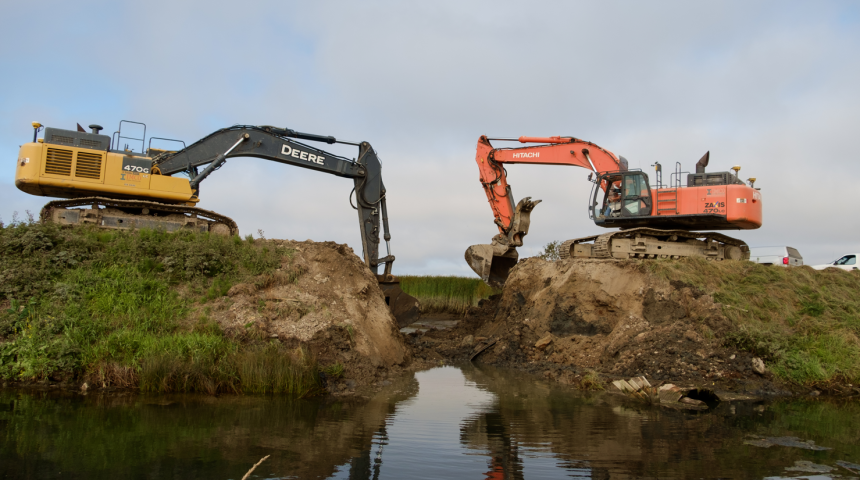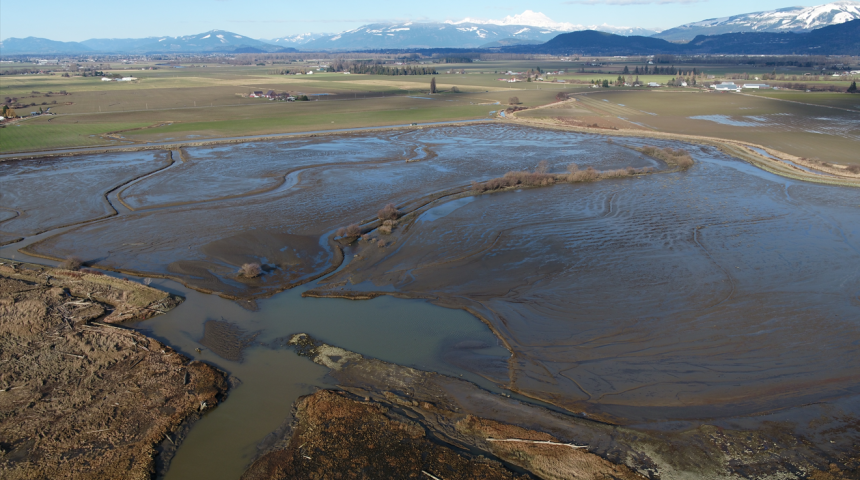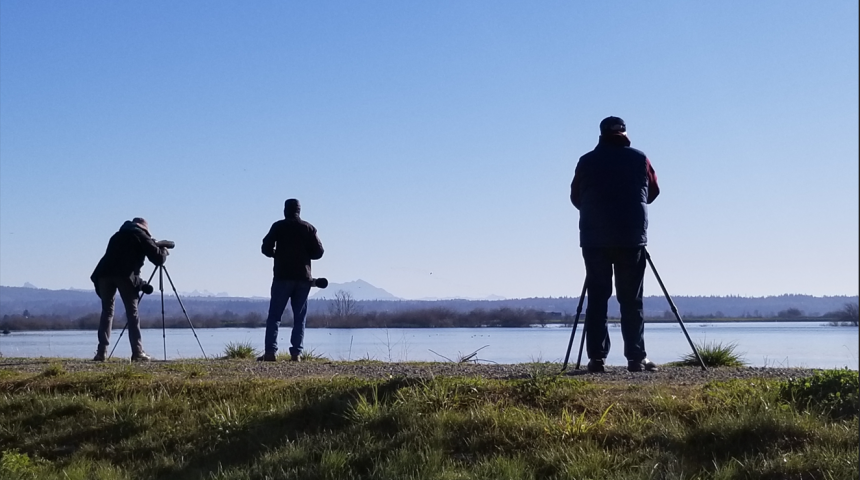The Fir Island Farm Reserve restoration project is located on the Fir Island Farm Reserve Unit of Skagit Wildlife Area and is within the WDFW-managed Snow Goose Game Reserve on Fir Island in the Skagit River Delta. The project set back about 5,800 feet of dike and restored 131 acres of tidal marsh and tidal channels, which are important habitats for juvenile Chinook salmon and other fish and wildlife. The project also incorporated protections to reduce flooding, maintain drainage, and prevent saltwater intrusion on surrounding farmland. Project feasibility started in 2011; construction was completed in 2016.
The project sought to balance a number of community needs as outlined below:
Recovering salmon populations
The Skagit River is the largest river draining to Puget Sound and supports all five native salmon species. Since the 1800s about 72% of the historic tidal marsh habitat has been lost. In 1999, the federal government listed Chinook salmon in Puget Sound – including those in the Skagit River – for protection under the Endangered Species Act. The Skagit Chinook Recovery Plan, developed in 2005, identified estuary restoration as a top priority for recovering Chinook.
This project contributed 131 acres of restored estuary, providing rearing habitat for juvenile Chinook salmon and benefitting other fish and wildlife species. Salt marsh and tidal channel habitats in the estuary are critical for migrating juvenile Chinook as they transition from fresh water to salt water. This essential habitat provides food and shelter for salmon to grow to sizes that increase their chance of survival in Puget Sound and the Pacific Ocean.
Protecting agricultural land
Since the late 1800s, people have been farming in the Skagit Delta, which is recognized as having some of the most agriculturally productive and valuable farmland in the world. Agriculture remains an important component of the local economy and community identity. Drainage and flood protection makes farming possible in the Skagit delta. These were important considerations as local agricultural leaders and WDFW worked together to design and build the Fir Island Farm Reserve project. WDFW worked closely with the local entity responsible for flood protection, drainage, and irrigation on Fir Island (District 22) to ensure the final project met their needs. A drainage storage pond and pump house were incorporated into the project to ensure adequate drainage, and the dike was designed to meet current design standards, including planning for sea level rise.
Maintaining the Snow Goose Reserve
The reserve is maintained as a non-hunting reserve for snow geese, shorebirds, and other waterfowl. The reserve attracts tens of thousands of snow geese each year between October and April. A driveway and short trail along the dike with benches and interpretive signs offer views of snow geese, shorebirds, and other wildlife against a background of Skagit Bay and the Olympic and Cascade Mountains.
Project benefits
The project restored 131 acres to estuary by reintroducing tidal processes that bring water, sediment, and nutrients to the marsh. The site now provides:
- Rearing habitat for tens of thousands of juvenile ESA-listed Chinook salmon each year
- Habitat for 20 other species of fish, including rearing habitat for juvenile chum, adult foraging habitat for ESA-listed bulltrout and cutthroat trout, and habitat for forage fish such as smelt
- Habitat for waterfowl, shorebirds, and other species that rely on estuaries
- Improved flood protection and drainage infrastructure serving Fir Island
- Continued management of 100 acres as a snow goose reserve with farmed waterfowl forage production
- Continued recreational access
Project details
Partners involved
WDFW partnered closely with Skagit County Consolidated Diking, Drainage and Irrigation Districts No. 22, which manages the flood and drainage infrastructure on Fir Island. WDFW coordinated with the District on all aspects of the feasibility and design work. The District took ownership of the dike and drainage infrastructure in 2020 following a post-project performance monitoring period.
Other entities involved in feasibility and design review included:
- National Oceanic and Atmospheric Administration
- Seattle City Light
- Skagit Conservation District
- Skagit Watershed Council
- The Nature Conservancy
- Western Washington Agricultural Association
Project design
Construction elements included:
- Building a 5,800-foot long setback dike that met current design guidelines including sea level rise predictions, and removing 3,400 feet of marine dike
- Building a 7-acre drainage storage pond and pump station
- Relocating tidegates
- Excavating 5 acres of tidal channel (in addition, the tidal prism on/off the site was expected to create 12 acres of channel in the existing marsh)
- Placing spoils to create high marsh areas
- Seeding native marsh plants
Project funding
Funding for the project was provided by:
- National Oceanic and Atmospheric Administration
- Washington State Salmon Recovery Funding Board
- The Nature Conservancy
- Puget Sound Partnership
- U.S. Fish and Wildlife Service
Environmental review
The Department needed federal, state and local permits for the project. WDFW provided information and sought input via a project website and public open houses, and through public comment periods associated with permits. WDFW also spoke with neighboring landowners during design and addressed their concerns.
Contact
Contact information
For more information, please contact Jenny Baker at Jenny.Baker@dfw.wa.gov or 360-855-8325.


